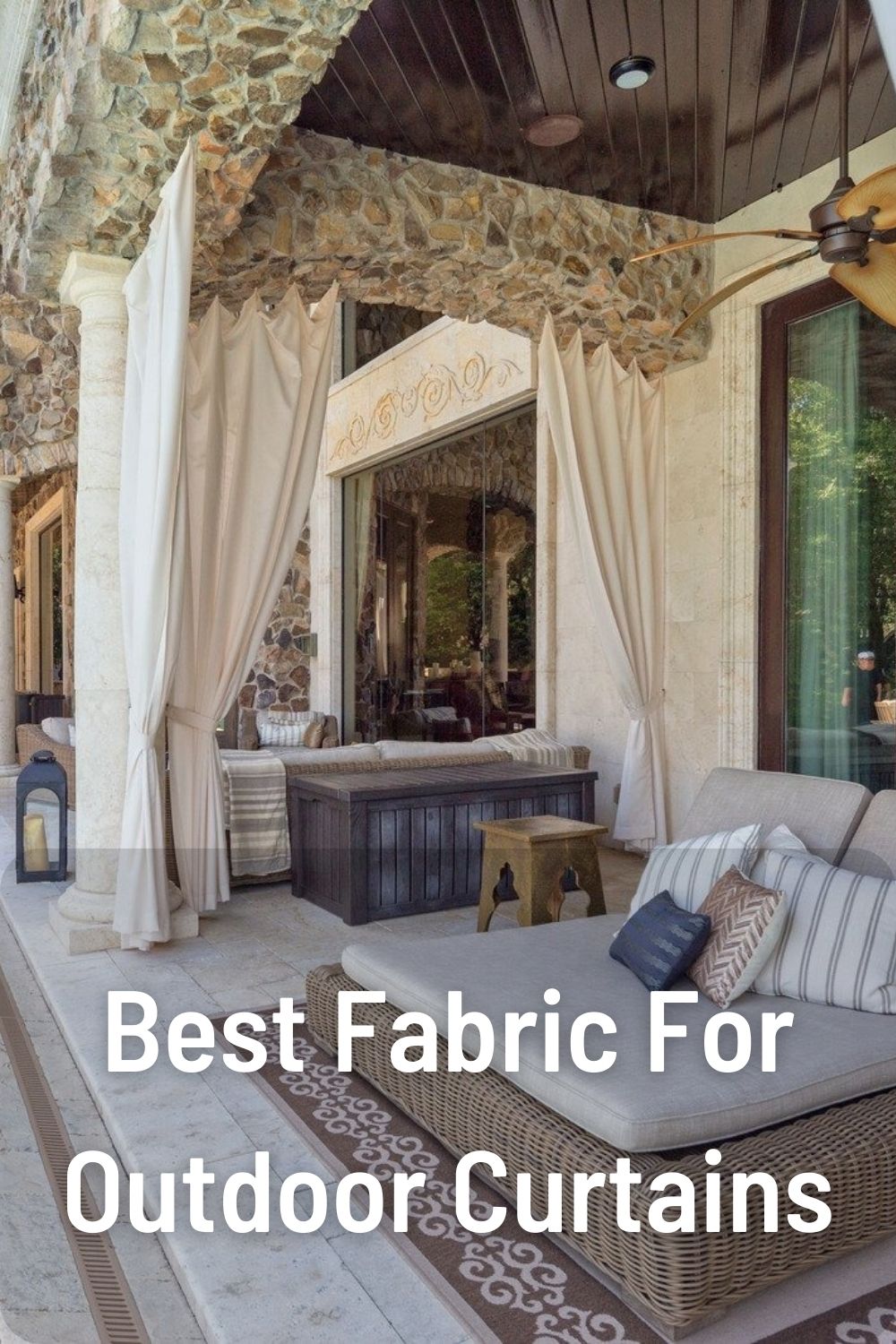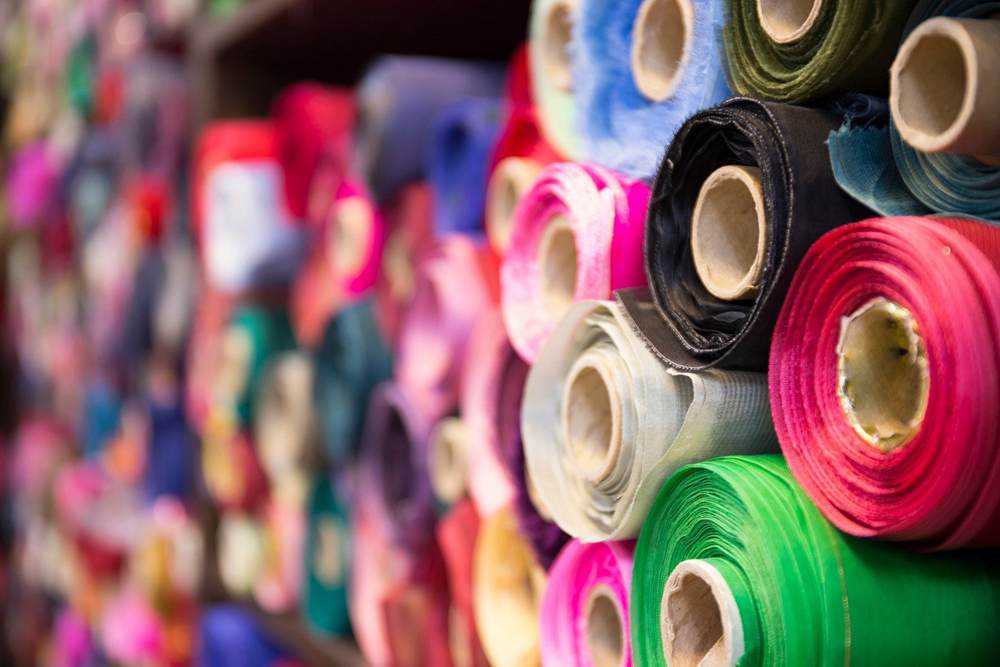
When choosing fabric for outdoor curtains, durability and weather resistance are key factors to consider. The fabric needs to stand up to sun, wind, and rain without fading, mildewing, or deteriorating. The right outdoor curtain fabric will protect your indoor furnishings from UV damage while providing privacy and enhancing your outdoor living space.
In this complete guide, we will cover the following topics to help you select the best fabric for outdoor curtains:
Table of Contents
Acrylic
Acrylic is one of the most popular choices for outdoor curtains. Here are some key advantages of acrylic fabric:
- Weather resistant – Acrylic repels water and moisture. It is highly resistant to mildew and UV damage.
- Durable – Acrylic is a sturdy, long-lasting fabric. It maintains its color and structure when exposed to sun and rain.
- Easy to clean – Acrylic can be machine washed and dried. It does not shrink or wrinkle easily.
- Breathable – The texture of acrylic allows air to circulate through the weave. This prevents heat and condensation buildup.
- Stylish – Acrylic outdoor curtains come in beautiful, rich colors and sheens. From solids to prints, there are many acrylic styles that enhance outdoor spaces.
Be sure to look for 100% acrylic rather than acrylic blends, which may not offer the same level of durability and performance. Sunbrella is a top brand for premium outdoor acrylic fabrics.
Polyester
Polyester is another synthetic fabric that makes a good outdoor curtain choice. Benefits of polyester include:
- Colorfast – Polyester fabric retains its color well when exposed to sunlight. It resists fading.
- Dries quickly – Polyester dries faster than other fabrics, which prevents mold and mildew growth.
- Wrinkle-free – Polyester outdoor curtains maintain their shape without wrinkling.
- Strong – Polyester is a very strong, resilient fabric. It stands up well to wind and rain.
- Low maintenance – Polyester can be machine washed and does not require ironing.
Polyester is more prone to static and may not be as breathable as other outdoor fabrics. Opt for 100% polyester with a tight weave.
Olefin
Olefin goes by several brand names including Sunbrella, Dickson, Firesist, and Dolphin. It is a type of polypropylene fabric made specifically for outdoor use. Key features include:
- Mildew, mold, and UV resistant – Olefin has excellent resistance to fading and deterioration.
- Waterproof – Olefin fabrics are waterproof and dry quickly. They are ideal for humid climates.
- Easy to clean – Olefin can be cleaned with soap and water. Many styles are machine washable.
- Soft feel – Olefin has a smoother, softer feel than other outdoor textiles. This makes it suitable for upholstery and clothing also.
- Stylish – From solids to bold graphics, olefin comes in a wide range of colors and patterns.
Olefin is more expensive than polyester or acrylic. But its durability and performance make it a worthwhile investment for outdoor curtains.
Canvas
Cotton canvas has a classic look and natural feel that makes an attractive outdoor curtain. However, it has some disadvantages for outdoor use:
- Poor UV resistance – Canvas fades and deteriorates quickly in sunlight. It needs re-treatment regularly.
- Prone to mildew – The natural fibers in canvas absorb moisture, promoting mildew growth.
- Requires special care – Canvas shrinks easily and needs line-drying and touch-up ironing.
- Not waterproof – Canvas absorbs water and dampness rather than repelling it.
If properly treated and maintained, cotton canvas can be a good option for covered outdoor spaces that get limited direct sun and rain. But other fabrics are lower maintenance choices.
Sunbrella
Sunbrella is a popular brand of outdoor fabric, made from acrylic or olefin. Here’s an overview of Sunbrella outdoor curtain fabric:
- Fade resistant – Sunbrella fabric retains its color and luster, even after years in the sun.
- Water repellent – Sunbrella fabric repels water, moisture, and mildew. It dries quickly after rain.
- Easy to clean – Sunbrella can be washed at home with mild soap and water. Many styles are machine washable.
- Durable – Sunbrella is designed to withstand sun, wind, rain, snow, and saltwater. It lasts for years with proper care.
- Stylish patterns – Sunbrella is known for its beautiful patterns and color palette. The fabric comes in over 150 stylish colors and designs.
- Breathable – The tight weave allows air to flow through Sunbrella fabrics.
- Warranty – Sunbrella offers one of the best warranties in the industry – 5 years for fabric integrity and 3 years for colorfastness.
With the right care, Sunbrella can maintain its beauty and performance for many seasons. The premium fabric commands a higher price but offers exceptional quality and durability.
Other Outdoor Fabrics
Here are some other fabrics that can work for outdoor curtains in certain circumstances:
- Polypropylene – This synthetic fabric resists fading, stains, and water. It’s a good budget-friendly option.
- Vinyl – Vinyl coated fabrics are waterproof and stain resistant. They work well for high traffic outdoor cafes and restaurants.
- Marine canvas – Treated to resist mold and mildew, marine canvas is thicker and more durable than regular canvas.
- Fiberglass – Curtains made of fiberglass strands sealed in PVC provide wind resistance while allowing visibility.
- Nylon – Nylon’s high strength makes it suitable for lightweight outdoor curtains. It dries quickly but is prone to UV damage.
Check the fabric specs carefully and match the material to your specific outdoor conditions. Many blended fabrics combine the benefits of different textiles.
Fabric Features to Look For

Here are some key performance features to look for when choosing outdoor curtain fabric:
UV Resistance
Exposure to the sun’s UV rays degrades fabrics over time. Fabrics specifically designed for outdoor use are treated to resist UV damage. Acrylic, polyester, and olefin have built-in UV stabilizers. Canvas needs UV inhibitors added via treatments. When possible, opt for fabric with a UV resistance rating of at least 1500 hours.
Water and Mold Resistance
Outdoor curtains need to repel rain and moisture. Water-resistant coatings coupled with quick-drying synthetic fibers prevent the growth of mildew and mold. Look for fabrics advertised as water repellent, moisture resistant, or mold/mildew resistant. Olefin and vinyl fabrics tend to have the highest water resistance.
Wind Resistance
In areas with high winds, choose fabrics with a tighter weave like Sunbrella that will stand up to gusts without tearing or fraying. Heavier canvases can also withstand stronger winds. Metal grommets help reinforce outdoor curtains against wind damage. Consider using wind chain or split rings to distribute force evenly across the top hem.
Breathability
Fabrics like cotton canvas can create a greenhouse effect trapping heat behind outdoor curtains. Synthetic fibers woven into breathable constructions allow air flow to prevent heat buildup. Check product descriptions for details on breathability or air permeability.
Durability
You want outdoor curtains that will last more than one season. Acrylic, polyester, and olefin have excellent longevity. Look for curtain fabric weight of at least 9 ounces per square yard. Heavier fabrics have higher thread counts and denser weaves. They resist tearing and hold up better over time.
Easy Care and Cleaning
Outdoor curtains get dirty and stained. Choose fabric that can be easily cleaned at home or commercially laundered. Machine washable fabrics offer the most convenience. Check if bleach can be used to remove mildew. Some fabrics only require mild soap and water.
Appearance
While performance comes first, outdoor curtains should also look attractive. Many outdoor-grade fabrics now come in beautiful colors, patterns, and textures to coordinate with any decor. Look for rich solids, colorful prints, or appealing textured weaves that will enhance your space.
Matching Performance to Location
| Location | Recommended Fabric |
|---|---|
| Full sun | Acrylic or olefin for UV resistance |
| Partial shade | Polyester or canvas can work |
| Hot and humid | Breathable, quick-drying synthetics |
| Heavily rained on | Water repellent vinyl or olefin |
| Windy | Tightly woven fabrics like Sunbrella |
| Salty coastal air | Acrylic or solution-dyed polyester |
Hanging and Care Tips
Follow these tips for properly hanging and caring for outdoor curtains to maximize their lifespan:
- Install outdoor curtain rods securely into wall studs using corrosion resistant screws. Use sturdy metal or PVC rods.
- Allow curtains to extend 3-4 inches past the edges of the window or opening to maximize coverage.
- Insert rust-proof grommets or brass eyelets every 6-8 inches along the top hem to reinforce and distribute weight.
- Use stainless steel hooks with lined ends (not bare metal) to hang curtains from grommets without damaging fabric.
- Use washers between the hooks and rings on a traverse rod to prevent friction damage.
- Close curtains when not in use to block UV exposure. Draw curtains together in the center or tie back with straps.
- Routinely hose down acrylic, polyester, olefin, and vinyl to wash away dirt, pollen, and bird droppings.
- For canvas, apply a UV and water repellent treatment each season. Mildew resistant treatments also help.
- Wash removable outdoor curtains once a season. Machine wash and line dry; tumble dry on low.
- Spot clean stained areas immediately with a mild detergent and spray-on fabric cleaner.
- Repair tears, holes or loose hems right away. Use an adhesive patch kit for minor damage.
Proper installation, care and maintenance will ensure your outdoor curtains retain their beauty and withstand the elements season after season.
Frequently Asked Questions
What is the most durable outdoor curtain fabric?
Olefin is the most durable outdoor fabric. It maintains its color, resists mildew and UV damage, and withstands years of sun, wind, and rain exposure. Brands like Sunbrella use olefin for premium outdoor curtains.
What fabric is best for outdoor shade curtains?
Acrylic fabrics made by Sunbrella and Outdura are excellent choices for outdoor shade curtains. The fabrics block UV rays, repel water, resist fading, and allow air flow to prevent heat buildup behind the curtains.
Can you put blackout curtains outside?
Blackout curtain fabric is not suitable for outdoor use. The blackout liner usually contains polyester fibers that degrade quickly in sunlight. Opt for regular outdoor curtain fabric in darker opacities to block outdoor light.
Should outdoor curtains be lined?
Lining improves insulation, light blocking, and privacy. Choose a coordinating solid or blackout lining made from acrylic, polyester, or olefin – not cotton. Make sure the lining fabric has outdoor performance qualities similar to the main curtain fabric.
How do I make my canvas curtains waterproof?
Treat canvas outdoor curtains with a fabric protector like 303 Fabric Guard. This adds water repellency while allowing breathability. Reapply every 2-3 months. Limit sun exposure and frequently hose off canvas curtains to prevent mildew.
Conclusion
Choosing the right fabric is the most important factor for outdoor curtains exposed to sun, wind, and rain. Look for UV-resistant, water repellent, mildew-resistant synthetic fabrics designed specifically for outdoor use. Acrylic and olefin offer the best durability. Opt for a heavier fabric weight with a tight weave. Allow for airflow and match the fabric performance to your climate and conditions. With proper installation and care, high quality outdoor curtain fabric will withstand the elements for many years of beauty and service.